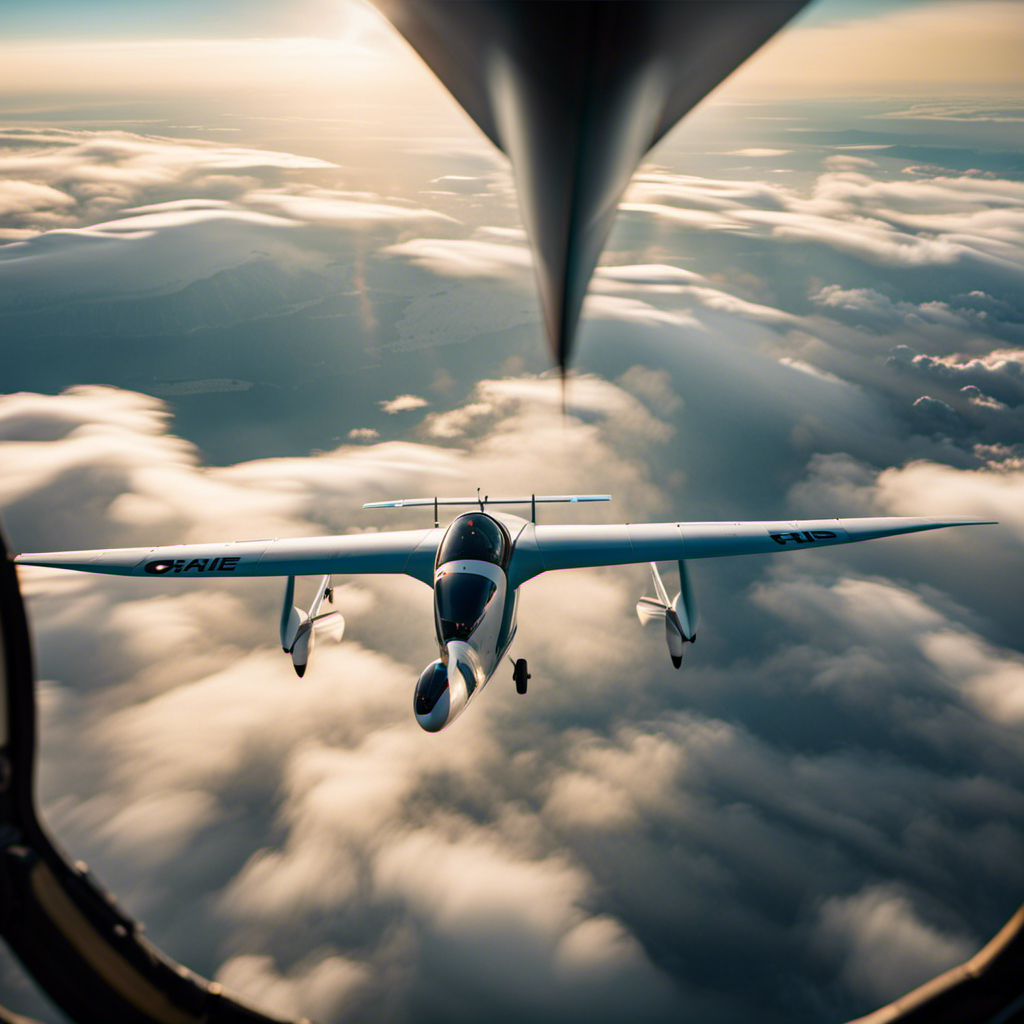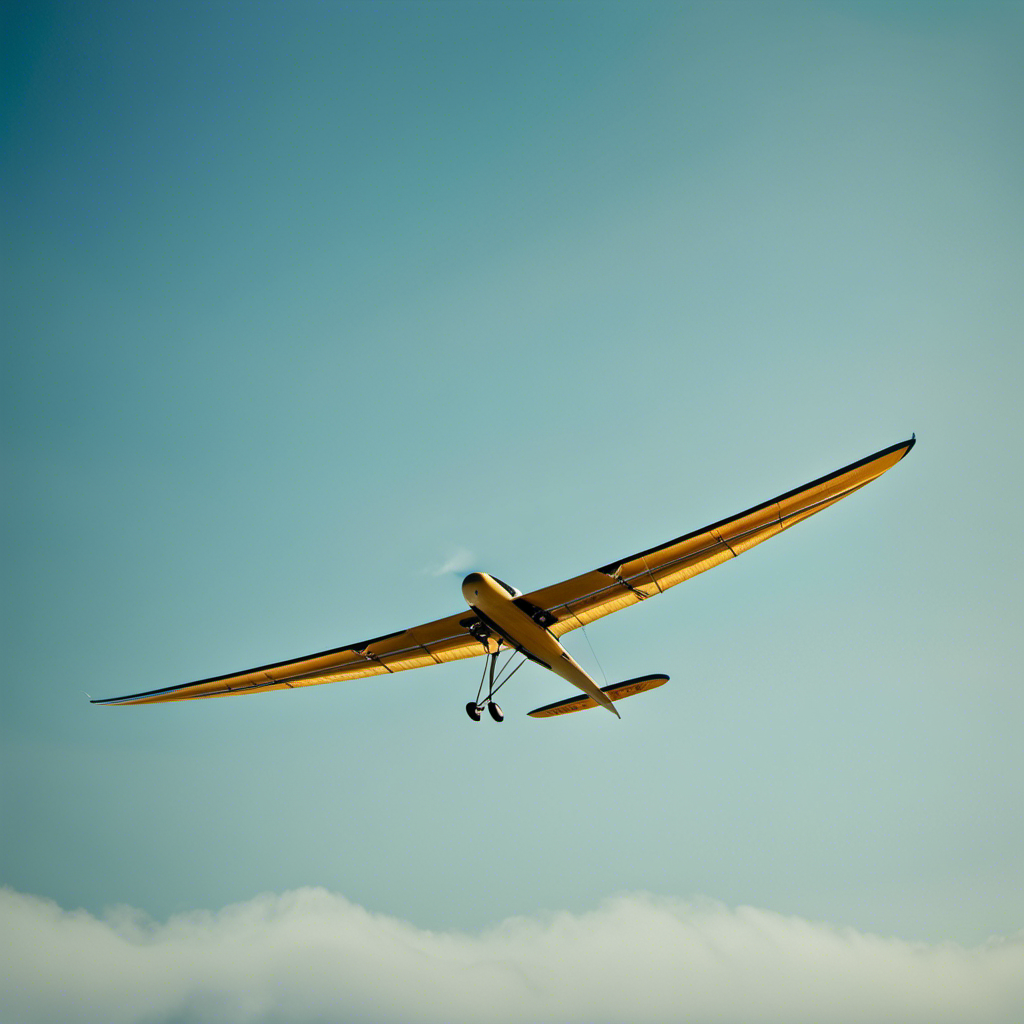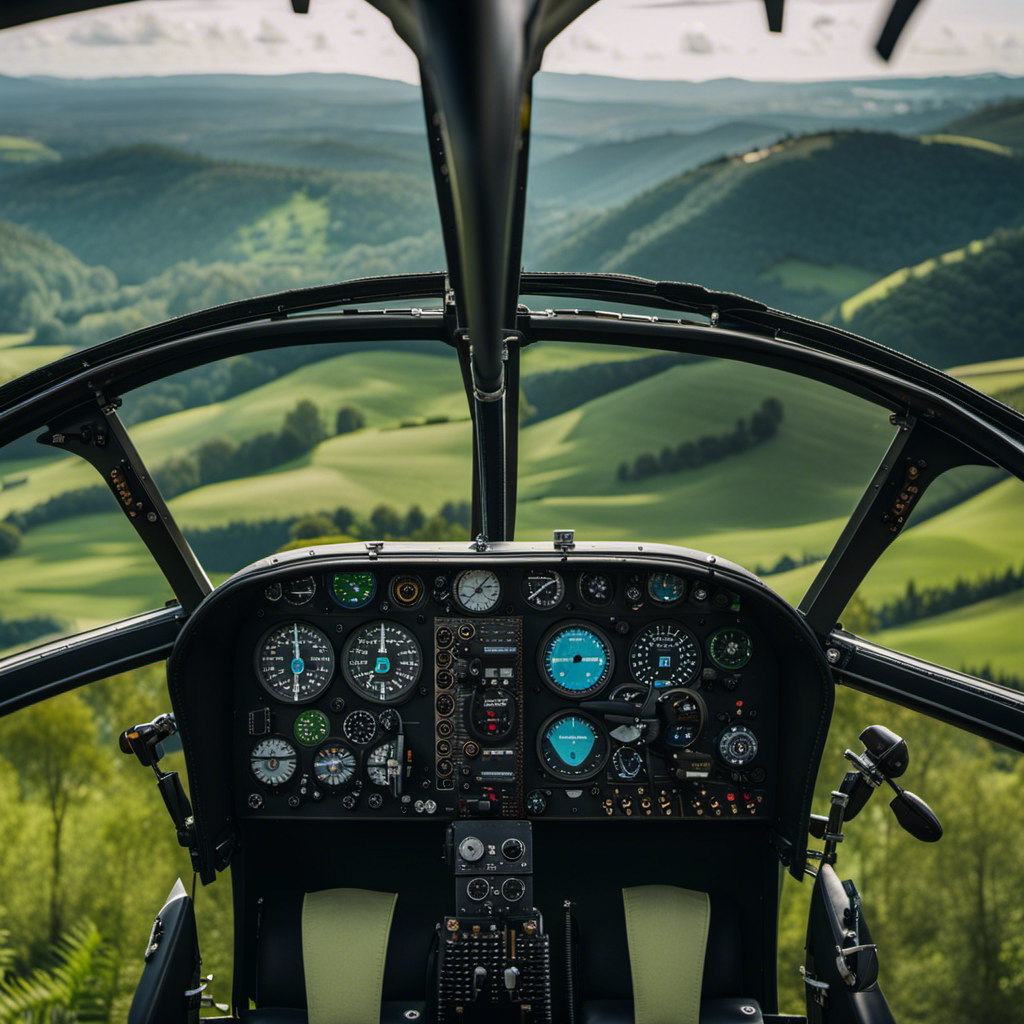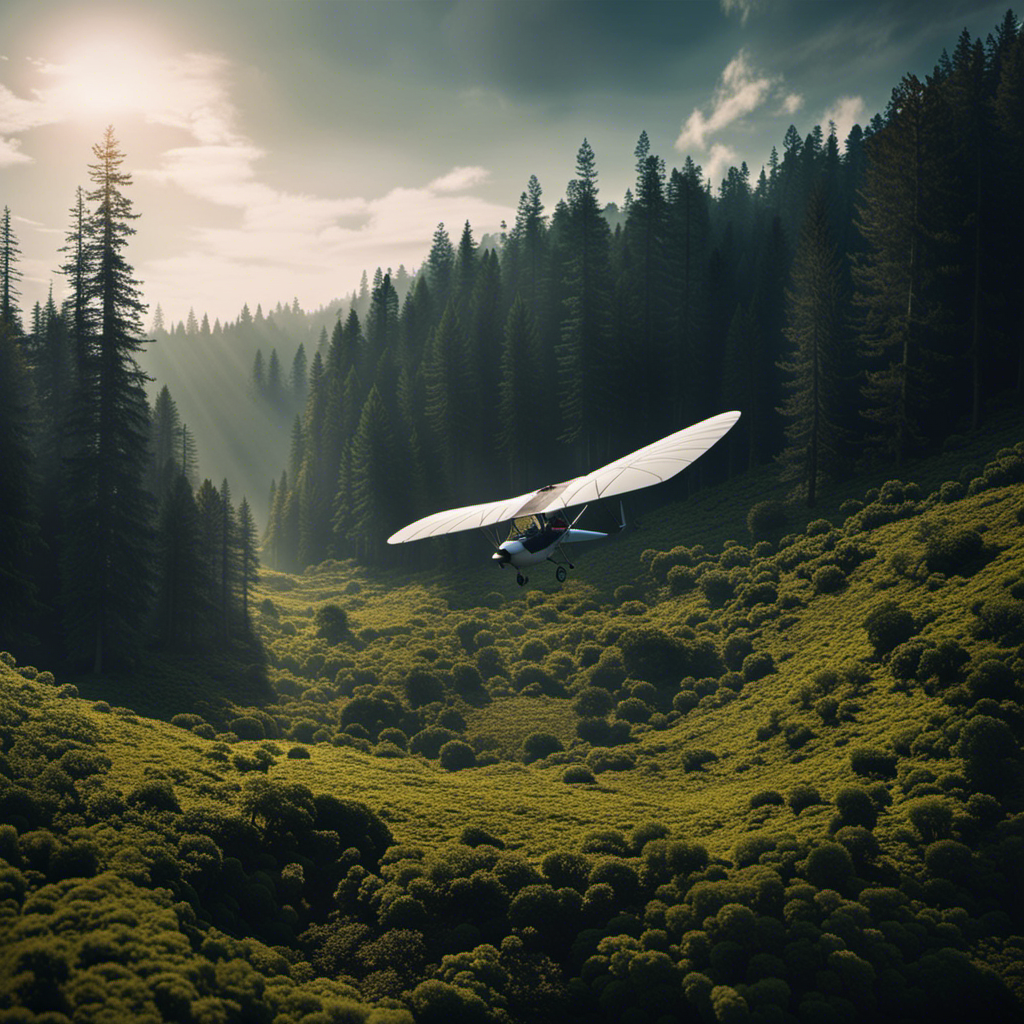Buckle up and soar with me as we embark on a thrilling adventure, exploring the world of two-seater glider planes.
In this comprehensive guide, I’ll take you through the basics of glider planes, finding the right one, preparing for flight, and mastering in-flight maneuvers.
We’ll also delve into the unique experience of flying with a partner, safety procedures, improving skills, and maintaining your glider plane.
Get ready to spread your wings and discover the freedom of glider flying!
Key Takeaways
- Understanding the basics of glider plane controls and lift and drag principles
- Evaluating the right glider based on size, weight, and performance factors
- Mastering in-flight maneuvers and safety procedures, including emergency protocols
- Taking off, landing, and navigating with proper techniques, considering runway selection and navigation methods
The Basics of Glider Planes
Now, let’s dive into the basics of glider planes and how you can pilot them. Glider plane controls are simple and intuitive, consisting of a stick and pedals. The stick, located between the pilot and co-pilot, is used to control the pitch and roll of the glider. By pushing the stick forward or backward, you can control the glider’s pitch, which determines whether the nose of the plane is pointing up or down. Similarly, moving the stick left or right controls the roll of the glider, allowing you to bank the plane to the side. The pedals, located on the floor, control the rudder, which is used for yaw control. By pressing the left or right pedal, you can control the glider’s direction.
Understanding glider plane aerodynamics is crucial for safe and efficient flying. Glider planes rely on the principles of lift and drag to stay airborne. Lift is generated by the wings as they move through the air, and it counters the force of gravity, allowing the glider to stay in the air. Drag, on the other hand, is the resistance encountered by the glider as it moves through the air. It is important to minimize drag to maximize the glider’s performance. This can be achieved by maintaining a smooth and streamlined shape, avoiding unnecessary protrusions or rough surfaces that can create drag.
Now that we understand the basics of glider planes and how they work, let’s move on to the next section, which focuses on finding the right glider for your needs.
Finding the Right Glider
When searching for the perfect glider, you’ll want to consider factors like size, weight, and performance. Choosing the right model is crucial to ensure an enjoyable and safe experience.
Start by evaluating the performance of different gliders. Look for models with a good glide ratio, which determines how far the glider can travel horizontally in relation to its descent. A higher glide ratio means a more efficient glider. Additionally, take into account the wing loading, which is the amount of weight the wings need to support. A lower wing loading allows for better maneuverability and control.
It’s also important to consider the glider’s stall speed, as a lower stall speed allows for slower and safer landings. Finally, take note of the overall weight and size of the glider, as this will affect its transportability and ease of storage.
Preparing for Flight
When it comes to preparing for flight, there are several key points to consider.
First and foremost, conducting pre-flight inspections and checks is essential to ensure the safety and functionality of the aircraft. This includes examining the glider for any signs of damage or malfunctioning parts.
Secondly, understanding weather conditions and wind patterns is crucial for a successful flight. It is important to stay updated on the current weather forecast and be aware of any potential changes or hazards that may arise.
Lastly, effective communication with air traffic control is vital for a smooth and coordinated flight. This involves following their instructions, reporting any issues or concerns, and maintaining clear and concise communication throughout the journey.
Conducting Pre-Flight Inspections and Checks
Before taking off, it’s important to conduct pre-flight inspections and checks on the glider plane. This ensures the safety and readiness of the aircraft for the upcoming flight.
As a pilot, I always follow a pre-flight checklist to ensure that no important steps are missed. The checklist includes visual inspections of the exterior and interior of the plane, as well as checking the functionality of various components such as the controls, instruments, and fuel system. I also perform a thorough examination of the wings, tail, and landing gear for any signs of damage or wear.
By following these pre-flight checks, I can confidently take to the skies knowing that my glider plane is in optimal condition.
Understanding weather conditions and wind patterns is crucial for a successful flight, as it allows me to choose the best routes and make informed decisions during the journey.
Understanding Weather Conditions and Wind Patterns
To understand weather conditions and wind patterns, you should check the local forecast and pay attention to factors such as temperature, wind speed, and precipitation. Weather forecasting plays a crucial role in planning and executing a safe glider flight. By analyzing weather reports and forecasts, you can make informed decisions about when and where to fly.
Additionally, wind tunnel testing is another valuable tool for understanding wind patterns and their effects on glider performance. By simulating airflow in a controlled environment, researchers can gather data on the aerodynamic behavior of gliders. This information helps pilots anticipate how wind conditions might affect their flight.
Understanding weather conditions and wind patterns is essential for a successful glider flight, as it allows pilots to navigate safely and efficiently through the skies.
When it comes to communicating with air traffic control, clear and concise communication is key.
Communicating with Air Traffic Control
Make sure you use clear and concise communication when talking to air traffic control. Effective communication is crucial for safe and efficient air traffic control procedures. To help you navigate this process, here are some key techniques to keep in mind:
| Communication Technique | Description | Example |
|---|---|---|
| Use Standard Phraseology | Stick to the prescribed phrases and terminology used in aviation communications. | "Cleared for takeoff runway 27." |
| Speak Clearly and Slowly | Enunciate your words and avoid speaking too fast. | "November Alpha Bravo, request permission to descend to 5,000 feet." |
| Listen Carefully | Pay close attention to instructions and read them back accurately to ensure mutual understanding. | "Roger, maintaining 2,500 feet, November Alpha Bravo." |
| Be Polite and Professional | Maintain a calm and respectful tone throughout your interactions with air traffic control. | "Thank you for your assistance, tower, November Alpha Bravo." |
| Maintain Radio Discipline | Avoid unnecessary chatter and only transmit when necessary. | "November Alpha Bravo, standby for clearance." |
Taking Off and Landing
When landing a 2 person glider plane, it’s important to maintain a steady descent. Landing procedures are crucial in ensuring a safe and smooth touchdown. Here are three key techniques to consider:
-
Approach Speed: As you prepare for landing, reduce your airspeed to an appropriate level. This will depend on the specific glider model, but a general rule of thumb is to maintain a speed slightly above the stall speed. This allows for better control and maneuverability during the descent.
-
Flare Technique: Just before touchdown, initiate the flare by gently pulling back on the control stick or yoke. This action raises the nose of the glider, reducing the descent rate and slowing down the aircraft. The goal is to make a smooth transition from descent to level flight just above the runway.
-
Touchdown Point: Aim for a specific point on the runway, usually a few hundred feet beyond the threshold. This helps maintain a consistent approach and allows for better judgment of the landing flare. It’s important to keep the wings level and smoothly transition into the roll-out phase after touchdown.
By mastering these takeoff techniques and landing procedures, you’ll be well-prepared for a successful landing.
Now, let’s delve into the next section, where we’ll explore in-flight maneuvers and techniques.
In-Flight Maneuvers and Techniques
As you’re flying, you’ll need to be aware of different in-flight maneuvers and techniques to ensure a smooth and controlled flight. Whether you’re looking to perform advanced aerobatic maneuvers or master cross country navigation techniques, understanding these skills is essential for a successful glider flight.
To give you a better understanding, let’s take a look at some advanced aerobatic maneuvers and cross country navigation techniques:
| Advanced Aerobatic Maneuvers | Cross Country Navigation Techniques |
|---|---|
| Loops | Dead reckoning |
| Rolls | Pilotage |
| Spins | GPS navigation |
Advanced aerobatic maneuvers like loops, rolls, and spins require precise control and coordination. These maneuvers can be thrilling to perform but should only be attempted by experienced pilots in appropriate conditions.
On the other hand, cross country navigation techniques involve using various methods to navigate over long distances. Dead reckoning involves calculating your position based on your estimated speed, heading, and time. Pilotage involves using visual landmarks to navigate, while GPS navigation utilizes satellite technology to determine your exact location.
Navigating and Exploring the Skies
After mastering the various in-flight maneuvers and techniques, it is time to take our glider plane to new heights and explore the vast expanse of the sky. Navigating and exploring the skies is an exhilarating experience that allows us to fully appreciate the freedom and beauty of flight.
One of the most thrilling activities you can engage in while soaring through the air is skydiving. As a skydiver myself, I can attest to the unparalleled rush of adrenaline that comes from jumping out of a glider plane and freefalling towards the earth. The feeling of weightlessness and the breathtaking views of the landscape below are truly unforgettable.
Another exciting aspect of navigating the skies is aerial photography. Armed with a camera mounted on the glider plane, you can capture stunning images from a unique perspective. Whether you are a professional photographer or simply a hobbyist, the opportunity to document the world from above is a dream come true. The freedom to soar above the clouds and capture breathtaking shots of landscapes, cities, and natural wonders is an experience that cannot be replicated on the ground.
Transitioning into the next section, flying with a partner opens up a whole new world of possibilities and challenges…
Flying with a Partner
If you want to enhance your flying experience, teaming up with a partner can bring a whole new level of excitement and challenges to your journey. Flying with a partner in a two-person glider plane requires excellent partner dynamics and effective communication techniques.
Partner dynamics involve understanding each other’s strengths and weaknesses, and finding ways to complement each other in the cockpit. Effective communication is crucial for a safe and enjoyable flight. Clear and concise communication ensures that both pilots are on the same page and can make decisions quickly and efficiently. It is important to establish a communication plan before takeoff, including using specific phrases or hand signals for different maneuvers or emergencies.
During the flight, maintaining open lines of communication is vital. Sharing observations, discussing strategies, and providing feedback to each other can help improve your flying skills and make the experience more enjoyable. It is also important to establish a balance between talking and focusing on the task at hand. Excessive chatter can be distracting and compromise safety.
As I transition into the subsequent section about safety and emergency procedures, it is important to note that effective communication plays a critical role in handling emergencies. Being able to communicate calmly and clearly during high-pressure situations can save lives.
Safety and Emergency Procedures
During the flight, it’s crucial to know the safety and emergency procedures for handling unexpected situations. Safety is paramount when flying, and being prepared for emergencies is essential.
One of the potential emergency situations in glider flying is an emergency landing. In the event of an emergency landing, it’s important to remain calm and follow the procedures taught during training. The pilot will communicate with the passenger, informing them about the situation and what to expect. They will demonstrate how to brace for impact and secure any loose items.
Additionally, knowing first aid procedures is crucial. In case of any injuries sustained during an emergency landing, it’s important to have a basic understanding of first aid. This includes how to assess the situation, administer CPR if necessary, and provide immediate care until professional medical help arrives. Understanding these procedures can help ensure the safety of both the pilot and the passenger.
Now that we have covered safety and emergency procedures, let’s move on to improving skills and advancing in glider flying.
Improving Skills and Advancing in Glider Flying
To improve your skills and advance in glider flying, it’s important to practice regularly and seek guidance from experienced pilots. Improving techniques and mastering advanced maneuvers requires dedication and a solid understanding of the principles of flight.
One of the key aspects of skill improvement is honing your ability to read the wind and thermals. By becoming attuned to the subtle changes in air currents, you can maximize your glider’s performance and stay aloft for longer periods of time.
Another technique to focus on is efficient energy management. Learning how to use gravity, wind, and thermals to your advantage will help you navigate the skies with ease and precision.
Additionally, practicing advanced maneuvers such as stalls, spins, and spiral dives under the supervision of an experienced pilot will enhance your flying abilities and boost your confidence. Remember, glider flying is a continuous learning process, and the more you practice, the better you’ll become.
By incorporating these techniques and seeking guidance from experienced pilots, you’ll be well on your way to becoming a skilled glider pilot.
As you progress in your skills and knowledge of glider flying, it’s equally important to ensure proper glider plane maintenance and care.
Glider Plane Maintenance and Care
After honing my skills and advancing in glider flying, I quickly realized that proper maintenance and care of my glider plane were vital to ensure its longevity and safety. Neglecting these aspects could not only lead to expensive repairs but also compromise the overall performance of the aircraft.
Here are some essential points to consider when it comes to glider plane maintenance and care:
-
Regular inspections: Conducting routine inspections is crucial to identify any potential issues or wear and tear. This includes checking the wings, control surfaces, landing gear, and cockpit instruments. It’s important to address any problems promptly to prevent them from escalating.
-
Cleaning: Keeping your glider plane clean is not just about aesthetics; it also plays a significant role in maintaining its performance. Regularly wash the exterior and remove any dirt or debris that may have accumulated during flights. Also, pay attention to the canopy, ensuring it is free of scratches or cracks that could impair visibility.
-
Storage: When not in use, store your glider plane in a suitable hangar or shelter to protect it from the elements. Extreme temperatures, moisture, and exposure to sunlight can have detrimental effects on the aircraft’s structure and components.
Frequently Asked Questions
How much does it cost to buy a 2 person glider plane?
The cost of buying a 2 person glider plane can vary depending on factors such as brand, model, and condition. It’s important to consider not just the initial cost but also ongoing maintenance requirements.
Can I fly a glider plane if I have a fear of heights?
Overcoming fear is possible when flying a glider plane, even with a fear of heights. Safety measures like harnesses and experienced pilots ensure a secure experience. Relaxing and enjoying the view can help alleviate anxiety.
What is the average duration of a glider flight?
The average duration of a glider flight depends on various factors such as weather conditions and pilot experience. However, typically, glider flights last between 30 minutes to 2 hours, providing a thrilling and immersive experience in the sky.
Are there any weight restrictions for flying in a 2 person glider plane?
Yes, there are weight restrictions for passengers in a 2 person glider plane. Safety precautions include considering the combined weight of passengers, ensuring the weight is evenly distributed, and following the manufacturer’s guidelines for maximum weight limits.
Do I need a pilot’s license to fly a 2 person glider plane?
To fly a 2 person glider plane, a pilot’s license is required. However, there are various training options available to obtain the necessary skills and knowledge for safe and enjoyable glider flying.
Conclusion
In conclusion, exploring the world of 2-person glider planes is like embarking on a breathtaking journey through the skies. It’s a thrilling experience that requires skill, preparation, and a keen sense of adventure.
From finding the perfect glider to mastering in-flight maneuvers, this comprehensive guide has provided valuable insights into the world of glider flying.
So spread your wings, feel the wind beneath you, and let the freedom of the sky be your guide. Happy flying!
With a heart that soars as high as the skies, Aria, affectionately known as “Skylark,” is the driving force behind Soaring Skyways. Her journey into the gliding world began as a young dreamer gazing up at the soaring birds, yearning to experience the weightlessness and freedom they embodied. With years of experience both in the cockpit and behind the scenes, Aria’s commitment to the gliding community is unwavering.










